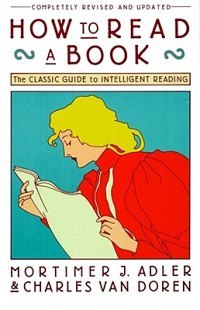
Besides the Bible, How to Read a Book by Adler and Van Doren (link is to my review) has been the foundational book of our high school at home program. It is an intense volume that teaches readers how get the most out of any book they read, as well as how to decide which few of the millions of available books are worth the effort.
As both a homeschooler and a reviewer, I dip into this book regularly, and recently I took some notes on the levels of reading most relevant to high school students.
The First Level of Reading: Elementary Reading
– the reading normally learned in elementary school, and also the level that remedial college reading classes often address. This is foundational, and any student who does not read fluently should focus on mastering this skill.
The Second Level of Reading: Inspectional Reading
-the art of skimming systematically to get as much as possible out of a book in a given amount of time, to learn everything that the surface alone can teach you. Most people do not realize the value of such inspectional reading, and “are thus faced with the task of achieving a superficial knowledge of the book at the same time that they are trying to understand it.” p 19
-two aspects:
Inspectional Reading 1: Systematic Skimming or Pre-reading, in which you have a limited time to decide if you want to read the book
- Look at the title page and the preface.
- Study the table of contents.
- Check the index to see crucial terms and look up passages containing them.
- Read the publisher’s blurb on the dust jacket.
- Look at the chapters that seem to be pivotal to the argument.
- Turn the pages, dipping in here and there, reading a paragraph or two, sometimes several pages in sequence, never more than that.
Note: When I’m deciding whether or not to read or assign a book, I usually first check out online reviews (GoodReads, Amazon, specific reviewers). If I have the book already, I usually start with the conclusion, and then move to the Table of Contents and the introductions to sections of chapters if there are any. If, before trusting the author’s judgement, I want to see what kind of research he or she has done, I begin with the bibliography, acknowledgements, and footnotes. Because of decades of practice, I usually know before steps 5 and 6 above whether or not I will want to read the book.
Inspectional Reading 2: Superficial Reading
“In tackling a difficult book for the first time, read it through without ever stopping to look up or ponder the things you do not understand right away.” If you go to the dictionary or other secondary sources prematurely, you will only be impeding your reading instead of helping it along. In fact, in your effort to master the fine points prematurely, you will miss the big points that the author is making (miss the forest for the trees) p 38.
Note: This is especially relevant when studying something like Shakespeare: first read an outline of the play, then watch it, and only after that begin the detailed study, as discussed here and in the comments here.
The Third Level of Reading: Analytical Reading
-thorough reading, the best you can do; an intensely active process that is complex, systematic, and, I would say, deliberate. “Reading a book analytically is chewing and digesting it… and is preeminently for the sake of understanding.” p19
Note: Most books are not worth this much effort, so choose carefully.
Stage 1, Rules for Finding What a Book is About:
- Classify the book according to kind and subject matter
- State what the whole book is about with the utmost brevity.
- Enumerate its major parts in their order and relation, and outline these parts as you have outlined the whole.
- Define the problem or problems the author is trying to solve. p 95
Stage 2, Rules for Finding What a Book Says (Interpreting its Contents)
- Come to terms with the author by interpreting his key words
- Grasp the author’s leading propositions by dealing with his most important sentences.
- Know the author’s arguments, by finding them in, or constructing them out of, sequences of sentences.
- Determine which of his problems the author has solved, and which he has not; and as to the latter, decide which the author knew he had failed to solve.
Stage 3, Rules for Criticizing a Book as a Communication of Knowledge
A.General Maxims of Intellectual Etiquette
- Do not begin criticism until you have completed your outline and your interpretation of the book. (Do not say you agree, disagree, or suspend judgement, until you can say, “I understand.”
- Do not disagree disputatiously or contentiously.
- Demonstrate you recognize the difference between knowledge and mere personal opinion by presenting good reasons for any critical judgement you make.
B.Special Criteria for Points of Criticism
- Show wherein the author is uninformed.
- Show wherein the author is misinformed.
- Show wherein the author is illogical.
- Show wherein the author’s analysis or account is incomplete.
The Fourth Level of Reading: Syntopical Reading
-comparative reading in which one reads many books on a topic, compares them, and constructs “…an analysis of the topic that may not be in any of the books.” p 20
Note: This level is beyond many high school students but is very worthwhile for any older teen or adult to learn. I may write detailed notes on it later.
—
Of course, in its 400+ pages How to Read a Book contains an enormous amount of explanation of these points and also applies them to various different kinds of reading. I highly recommend the book for high school students and anyone else who learns from books, and hope that these notes encourage you to study the book.
For a detailed discussion of how we use it in our homeschool, read my review .
—
This is linked to Saturday Reviews, Booknificent Thursdays, Literacy Musings Monday, and The Book Nook.
For more encouragement, visit Finishing Strong, Trivium Tuesdays, Raising Homemakers, Titus 2 Tuesday, R&R Wednesdays.
Disclosure: I bought this book second hand many years ago. I am not compensated for this post in any way and have provided my own honest opinion.





